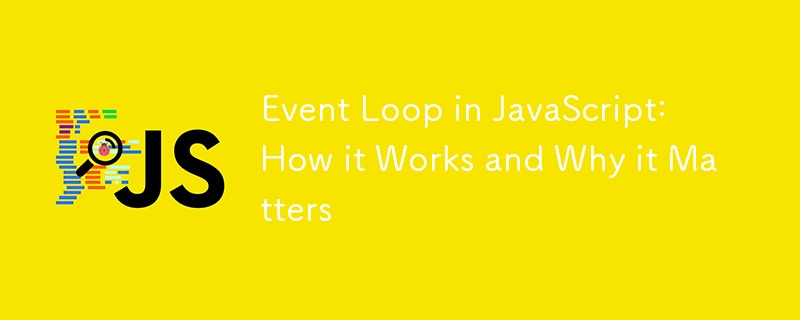
JavaScript는 단순함에도 불구하고 내부적으로 실행되는 복잡하고 강력한 엔진을 가지고 있습니다. 이 엔진의 가장 중요한 측면 중 하나는 이벤트 루프입니다. 이벤트 루프를 이해하는 것은 JavaScript 개발자에게 매우 중요합니다. 이벤트 루프는 비동기 작업을 처리하고 코드의 원활한 실행을 보장하며 성능을 최적화하는 데 중요한 역할을 하기 때문입니다. 이 기사에서는 JavaScript의 이벤트 루프가 어떻게 작동하고 왜 중요한지 자세히 알아보고 이해를 돕기 위한 실제 사례를 제공합니다.
이벤트 루프는 여러 코드의 실행을 관리하고 비동기 이벤트를 처리하며 JavaScript 엔진이 효율적으로 작동하도록 보장하는 JavaScript 런타임의 기본 부분입니다. 이를 통해 JavaScript는 비차단 및 단일 스레드가 가능하므로 사용자 인터페이스를 중단하지 않고도 여러 작업을 처리할 수 있습니다.
이벤트 루프의 작동 방식을 이해하려면 관련된 주요 구성 요소를 파악하는 것이 중요합니다.
이벤트 루프는 콜 스택과 콜백 큐를 지속적으로 확인합니다. 호출 스택이 비어 있으면 대기열에서 첫 번째 콜백을 가져와 호출 스택에 푸시하여 실행합니다.
다음은 이벤트 루프를 설명하는 간단한 예입니다.
console.log('Start');
setTimeout(() => {
console.log('Timeout');
}, 0);
console.log('End');
예상 출력:
Start End Timeout
이 예에서는 console.log('Start') 및 console.log('End')가 동기 작업이고 호출 스택으로 푸시되므로 먼저 실행됩니다. setTimeout 함수는 비동기 작업이므로 해당 콜백이 콜백 대기열로 푸시되고 호출 스택이 비어 있는 후에만 실행됩니다.
이벤트 루프를 이해하는 것은 여러 가지 이유로 중요합니다.
Promise는 기존 콜백에 비해 비동기 작업을 처리하는 더 읽기 쉬운 방법을 제공합니다.
console.log('Start');
fetch('https://jsonplaceholder.typicode.com/posts/1')
.then(response => response.json())
.then(data => {
console.log('Data:', data);
});
console.log('End');
예상 출력:
Start
End
Data: {userId: 1, id: 1, title: '...', body: '...'}
이 예에서 fetch 함수는 네트워크 요청이 완료되면 확인되는 Promise를 반환합니다. then 메서드는 응답을 비동기적으로 처리하는 데 사용되어 호출 스택이 차단되지 않도록 합니다.
Async/await 구문은 비동기 코드를 동기 코드처럼 보이고 동작하게 하여 가독성을 향상시킵니다.
console.log('Start');
async function fetchData() {
const response = await fetch('https://jsonplaceholder.typicode.com/posts/1');
const data = await response.json();
console.log('Data:', data);
}
fetchData();
console.log('End');
예상 출력:
Start
End
Data: {userId: 1, id: 1, title: '...', body: '...'}
여기서 fetchData 함수는 wait를 사용하여 fetch에서 반환된 Promise가 해결될 때까지 실행을 일시 중지하므로 코드를 더 쉽게 읽고 유지 관리할 수 있습니다.
The Event Loop processes two types of tasks: macrotasks and microtasks. Understanding the difference between them is crucial for optimizing your code.
Macrotasks: These include events like setTimeout, setInterval, and I/O operations. They are queued in the callback queue and executed one at a time.
Microtasks: These include Promises and mutation observers. They are queued in the microtask queue and executed immediately after the current operation completes, but before any macrotasks.
console.log('Start');
setTimeout(() => {
console.log('Timeout');
}, 0);
Promise.resolve().then(() => {
console.log('Promise');
});
console.log('End');
Expected Output:
Start End Promise Timeout
In this example, the Promise is a microtask and is executed before the setTimeout macrotask, even though both are scheduled to run after the current stack is clear.
How does the Event Loop handle DOM events?
The Event Loop handles DOM events through the Web APIs, which queue the event callbacks to the callback queue when the event is triggered. These callbacks are then processed by the Event Loop.
Can the Event Loop process multiple callbacks simultaneously?
No, the Event Loop processes one callback at a time. JavaScript is single-threaded, so it can only handle one operation at a time in the call stack.
What happens if a callback takes too long to execute?
If a callback takes too long, it can block the call stack, causing delays in processing other callbacks. This can lead to a sluggish user interface. To prevent this, break down long-running operations into smaller tasks using asynchronous techniques.
How do Web Workers relate to the Event Loop?
Web Workers run in separate threads from the main JavaScript execution thread, allowing you to perform background tasks without blocking the Event Loop. Communication between the main thread and Web Workers is handled via message passing.
Why is understanding the Event Loop important for performance optimization?
By understanding the Event Loop, developers can write more efficient code that handles asynchronous operations better, reduces blocking, and ensures smoother user interactions.
How do async/await and Promises fit into the Event Loop?
Async/await and Promises are abstractions over the Event Loop's asynchronous handling. Promises are microtasks that execute after the current stack is clear, and async/await syntax provides a cleaner way to write and manage these asynchronous operations.
The Event Loop is a core concept in JavaScript that ensures efficient execution of code, handling asynchronous operations smoothly, and maintaining a responsive user interface. Understanding how it works and leveraging its capabilities can significantly improve your coding skills and the performance of your JavaScript applications. Whether you're handling simple callbacks or complex asynchronous operations, mastering the Event Loop is essential for any JavaScript developer.
위 내용은 JavaScript의 이벤트 루프: 작동 방식 및 중요한 이유의 상세 내용입니다. 자세한 내용은 PHP 중국어 웹사이트의 기타 관련 기사를 참조하세요!